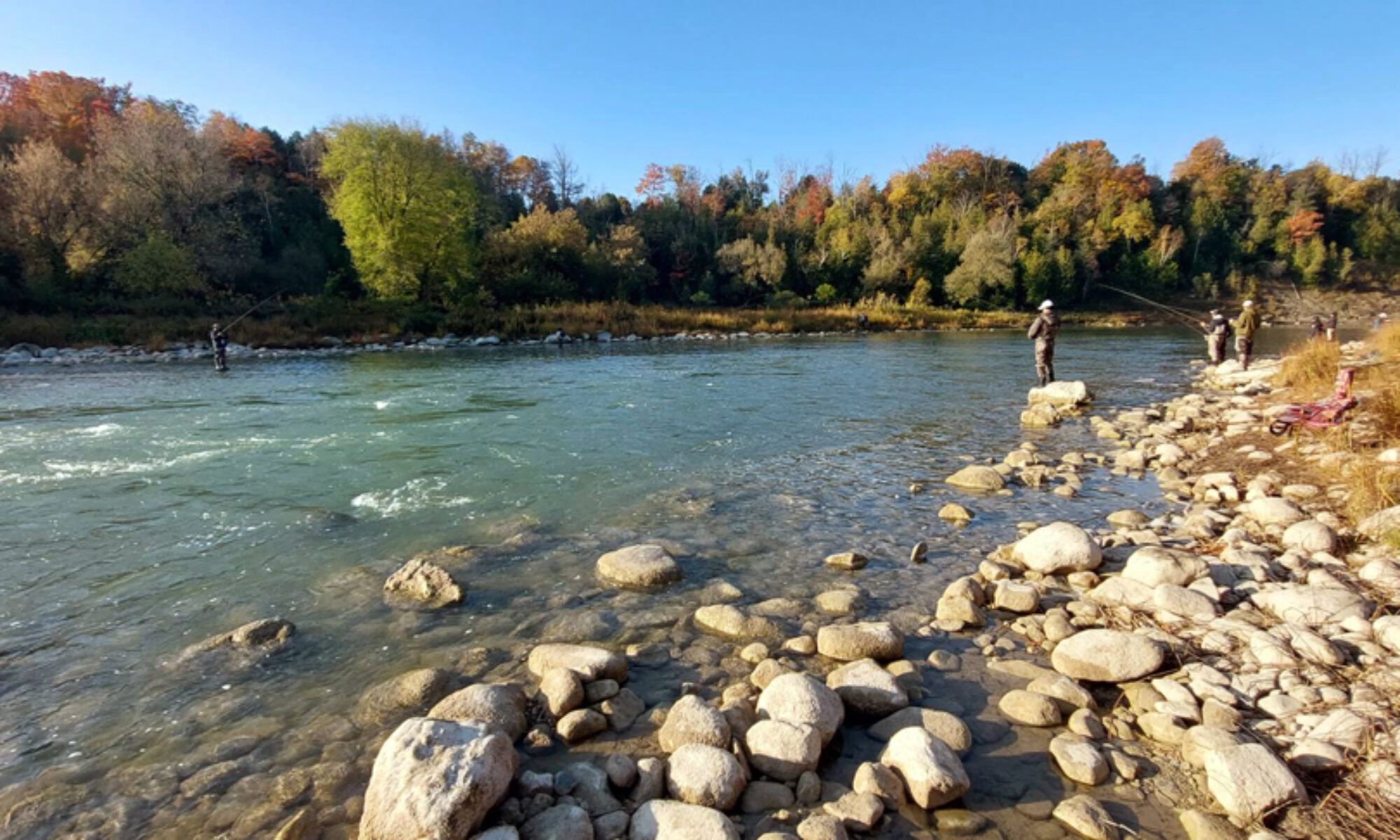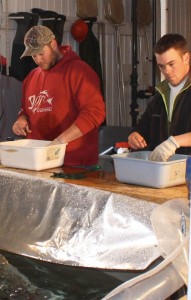My first steelhead came on the second cast of my first outing. That’s lucky, right? Sure it is, considering the reason it took two casts was because I had to land the coho that ate my little Cleo on the previous cast of that same outing. I don’t believe much in luck but in retrospect, luck had everything to do with it because it took me two more full seasons to catch my second steelhead and two more after that before the light really turned on. Ironically, I remember saying to me, as that first steelhead glided into my hand just minutes after landing the coho, “Shoot, this great lakes fishing is easy!”
That was in 1991 but by 94 I had them pretty much dialed in, but not before I had to relearn just about everything that I knew about fishing and when I started to pursue them with a fly rod, the learning curve got even steeper. So what did a transplanted Atlantic salmon fisherman do to consistently catch fish? The first thing I did was familiarize myself with the guys that caught a lot of fish and then I tried to do what they did. The centre pin thing didn’t do it for me but I quickly caught on that a good quality bait caster should provide similar results, so I bought what was at the time a decent reel, a used 10 ½’ casting rod and an assortment of floats. That augmented my current spinning outfit and I felt reasonably confident that I could begin steelhead fishing. The second thing that I did was familiarize myself with the species and try to get a feel for the “whys” as well as the “hows”. I knew enough about anadromous fish to have an idea of what I needed to do but the fish in the Great Lakes are not truly anadromous in that the Great Lakes are not salt water. This required a bit of research but I wasn’t surprised to find that despite the lack of salt, the Great Lakes steelhead are for all intents and purposes, steelhead just the same and what makes them steelhead is a brief but important life stage known as “smoltification”.
Smoltification: Definition: noun, Internal metabolic processes when a fish adapts from freshwater to marine water to avert stress. Supplement: This is mostly observed in salmonid fish. The metabolic processes involve physiological, morphological, biochemical and behavioral changes. For example, a salmonid fish develops a silvery color and tolerance for seawater when about to migrate downstream and enter the sea.
Without this stage and in all likelihood, the rainbow trout that are often stocked in the Great Lakes, be it in the U.S. or Canada, would not migrate to the lakes and instead would stick around the rivers to develop what we would consider a “resident” population. This all makes sense when you consider that the original eggs transported to the great lakes from the Pacific West coast, by most accounts were in fact steelhead eggs from the McLeod River in California.
Scientific mumbo jumbo aside, let’s look at what we know (or think we know) about steelhead in the Great Lakes. They begin to move into the rivers in the fall usually around the end of September. The timing will vary greatly from system to system but a safe bet to get serious about going after them is Thanksgiving weekend (Canada). Usually at this time, water temperatures and levels are in line and fish will enter in numbers. For those who can tolerate the foul weather that is more often than not found in November and December, this period can offer the best angling opportunities with the least amount of competition. The run continues until the weather shuts them down. Typically, by early January the run has slowed to a crawl and the cold water temperatures and ice at the river mouths and into the estuaries will prohibit any mass movement. On that note I’ll add this: it has been the belief for as long as I have been steelhead fishing that there are two distinctive strains in the Great Lakes that result in two different migration periods: fall and spring. Based on years of observation, I’ve argued that there is only one strain and that they begin their ascent in the autumn and that ascent is slowed or sometimes halted only by the weather. This is only important when one recognizes that not every winter is harsh and intolerable even in southern Ontario as evident throughout this past winter (2012).
The run on the Saugeen never really slowed for any extended period and to my knowledge there was very little or no ice at the mouth in Southampton. What all of this translated to was large numbers of steelhead entering the river all winter and very consistent fishing through late December, January and February. Further to that, the majority of the fish were in the system by mid-march and the best angling opportunities were over before the trout season even opened. The point to all of this is that if one has a flexible schedule and can keep an eye of the weather, there is seldom a need to put away your fishing gear as odds are good that you can find some open water and fish somewhere within a couple of hours of where you live.
What do you need to get started?
We can break presentations down into three categories: spin fishing, float fishing and fly fishing. Let’s assume that if you’re reading this, you’ve done some fishing in the past and the steelhead thing is something you’ve wanted to try. If you’ve done some fishing, odds are you’ve cast a spinning rod so I’ll begin there. Your basic steelhead spinning outfit would require a rod between 8 and 11 feet of med action. The longer lengths allow you to cast further and manage your line on the water better than with the standard 6 and 7 foot rods. In the reel department, most of the $100.00 + products available from manufacturers like Shimano or Quantum will work fine for the average guy but you want to do your homework. Unlike bass or walleye, these fish will test a drag system to the limit and it’s important to put your trust in the hands of the pros. Purchase what you can afford and if you have to compromise while making your rod and reel purchase, I’d say spend a bit less on a rod to acquire a higher quality reel. In terms of lures, I got by in my first couple of years of steelhead fishing with one box containing about two dozen or so spoons and spinners and of that assortment four or five caught 75% of the fish that I hooked. Little Cleo’s between 1/4oz and 2/5oz and Blue Fox Vibrax spinners from size 1 to 3 in blues, reds and fire tiger would round out my metal baits. Add to that an assortment of body baits in the medium size ranges in the same colors as these baits are a nice alternative and give one the ability to slow down his presentation.(more on that in a bit.) Lures are subjective and it takes a while to gain confidence but in my opinion, lure selection is far less important than presentation and if you watch the guys that catch a lot of fish with spinning gear, they are focused as hell on every cast and 100% in tune with their lure. My favorite presentation was to set up on a run and quite simply cover the water with a 45 degree cast across and downstream. As soon as the lure hit the water, I would flip the bail and lift the rod tip to pick up the lure and then begin a very deliberate swing across the current to a point directly below my position. Depending on the current, a slow retrieve may be necessary but often just letting the lure hang in the current and slide laterally across the run is all it takes. I won’t get into how to detect a strike; suffice to say, you won’t miss it. Having an assortment of weights will allow you to react to different speeds or flows but slow and deliberate are the keys in most cases. To slow things down to a crawl, I went with body baits like Kwik Fish or Flat Fish with a sinker 18 to 24 inches above the lure. This gives you the ability to really finesse your way across a current and pick it apart better than with a heavier bait, like a spoon that sinks rapidly. It will take some time to get a feel for the right speed and lure action but stay with it as there are few things more exhilarating than a steelhead hammering a slowly swung lure.
Float or Drift fishing
If you’ve ever been a bit serious about taking up the steelhead game than you have no doubt held in your hand or maybe even had someone show you how to use a center pin reel. Center pin reels are the mainstay of steelhead anglers on the Canadian Great Lakes and for good reason: in the right hands, they are deadly. Many of these reels used are the pinnacle of engineering and machining in the fishing tackle world and that combination has made for the perfect fish catching machine. Without getting into the science too much, it’s the spool and spindle of the reel that makes it. There are several different designs but in a nut shell, the spool spins like crazy and allows the angler to keep his float and bait at a consistent speed and depth almost indefinitely or for at least as long as you can see your float. This is important because the longer your bait is in the zone, the greater your odds are. Center pins have their limitations, though as there is a demographic out there, myself included, who lack motor skills or hand eye coordination. In fact, it’s only by the grace of god that we can wipe our own nose and for those individuals, center pins may not be the answer, at least to begin with. So what can one do to achieve similar results without the learning curve of a center pin reel? The answer is the bait caster. All of the major manufacturers make a number of casting reels in the $75.00 to $200.00 range and the modern bait casters are far easier to master than the center pin. I’m not going to get into the mechanics. Suffice to say, when casting, the combination of the centrifugal break and the cast control knob being set correctly will allow one to cast as far as he needs to in most steelhead situations. After the float has cocked you can then re-deploy the casting button and start the spool spinning as the float against the current takes line off the reel. You want to maintain contact or at least keep your thumb close to the spool as you don’t want it to over run and you need to be able to react when the float goes down. Upon this happening, it’s a simple matter of pressing your thumb against the spool and setting the hook. With the fish on, a quick half turn of the handle engages the drag and the fight is on. It should also be mentioned that a similar presentation can be achieved with a spinning reel but control is compromised. However, when fishing pocket water or smaller systems where long, controlled drifts are not required, it’s difficult to beat a spin set up with a float rig.
Setting the weights under a float is a science unto itself and if you ask five different anglers, you can get five different set ups. On the west coast, the rule of thumb is concentrating the weight near the bait and allowing it to plummet quickly into the zone. As a rule of thumb, the shorter the drift the quicker you want the bait to sink. So if you’re fishing a short and relatively shallow pocket, say 50 feet or so, placing more weight closer to your bait will achieve this result. In long, deep runs that may allow you to fish for several hundred feet, staggering the weights along your leader but placing them closer together as you get closer to the bait will allow the leader and terminal end to stay more true while drifting through varying currents. The standard line setup is fairly simple: start off the reel with something stout like 15lb braid or a stiff monofilament. To that add a barrel swivel and a leader of 10 to 15 lb fluorocarbon. This section is where you will place your shot and its length depends on the rivers depth and flow. Add another barrel swivel to the end of the leader and to that, you’ll add a tippet of 4 to 12 lbs. fluorocarbon (clear water requires lighter line and the more stained the water is, the heavier you can go).
Fly Fishing
Fly fishing for steelhead is often seen as either very difficult or thought to be an extremist’s pursuit. Extremist in that the photo’s in magazines often depict anglers holding a fish up that you can barely see through the squall and three inches of snow on the brim of their hat. To some degree around the Great Lakes that is the case but certainly not for the entire season. Trout fishers often put their gear away at the end of September with the winter blues already setting in and don’t realize that they are missing out on some of the best angling opportunities of the year. Another myth is that they are difficult with a fly but in reality, even the most seasoned float angler that uses roe on a regular basis will tell you that often, artificial flies are all you need. In simplest terms, if you already fly fish for trout and have become a proficient nympher, all you have to do for steelhead is make everything a bit bigger. Sounds simple enough but with the exception of a couple of additions to the terminal set up, my nymph rig for steelhead is basically an upsized nymph rig for trout. This is a description of a basic steelhead high stick rig.
1/I typically run two flies until I establish a pattern. Nymph and egg.
2/Basic nymph rig: 3 to 4ft of 22 to 26 lb off the fly line and add a barrel swivel. To that add 4 to 7ft of 12 to 15lb (depends on what you can handle and the depth) and then add another barrel swivel. To that, add 12 to 15 inches of 6 to 10 lb fluorocarbon for tippet and leave about 3inches of the tag. To this,(the tag) you will add your split shot after tying in an over hand knot its end, then add your fly to the tippet. If you add a dropper fly, tie it to the first fly off the hook.
The heavy butt section gives you a piece to place your indicator and lots of room to move up or down. The second section, being lighter, cuts through the current far better than a tapered leader.
To establish your indicator depth and weight formula, start with what you think you need in terms of both and then make small adjustments to the indicator and add or subtract shot until you reach the point where you are setting your hook on every 5th or 6th cast. By setting the hook, I mean that the indicator is moving or stopping as a result of the bottom or a fish. And that should do it. Here is a link to two relevant articles on my website that may help in understanding some questions that may come up. http://www.thehomepool.ca/learning.html
Regardless of your angling method, Great Lakes Steelhead rank among the most compelling fresh water quarry on the planet and many seldom or never sample the fun. They are no more difficult to catch than anything else and you don’t have to spend an arm and a leg to experience it. There is little substitute for good instruction followed by practice and for the very serious, there are a number of shops in the area that offer classes that will greatly flatten the learning curve be it in any of the aforementioned disciplines.










